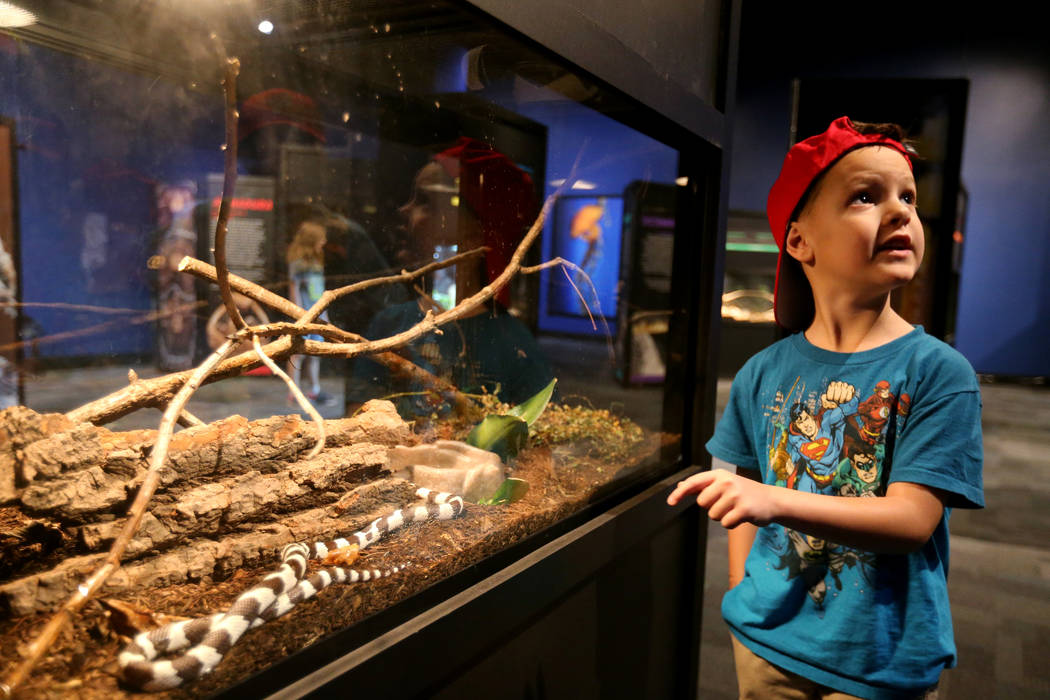‘Nature’s Ninjas’ brings armadillos, snakes to Springs Preserve












Hedgehogs and geckos and snakes, oh my!
Shape-shifting armadillos that can roll themselves into armor-plated balls. Color-changing chameleons that glow in crayon hues. Pink-toed tarantulas that look like they’ve just had pedicures, and poison dart frogs that — well, the name says it all.
Just a few of the “Nature’s Ninjas” spending the summer at the Springs Preserve.
The new exhibit, which runs through Labor Day, is augmented by a 25-minute live show — with two shows on weekdays, three on weekends, that focus on animals united by their defense mechanisms: everything from camouflage to venom.
The featured creatures include reptiles, amphibians, arachnids and even birds, all displayed in enclosures designed to replicate the environments they’re used to, whether steamy tropical surroundings or parched desert.
In one glass case, a flat Pipa pipa toad (also known as a Surinam toad) stretches out alongside a rock that’s exactly the same stone color.
In another, iguanalike bearded dragons laze, secure in the knowledge that their thick skins, edged with tiny spikes, will help protect them from predators. A mata mata turtle, meanwhile, patrols a watery enclosure. And a shy hedgehog burrows, almost out of sight, in his glass-enclosed case.
“Especially when you have a traveling exhibit, you want to get (the environments) as perfect as possible,” says Shawn Adderley, director of mobile exhibits and head zookeeper for Little Ray’s Reptile Zoo of Ottawa, Canada, which organized the Springs Preserve exhibit.
From hedgehogs to hissing cockroaches, “Nature’s Ninjas” offers “a very good selection of animals,” says naturalist Cameron Mcsheffrey, one of two Little Ray’s staffers who’ll be spending the summer at the Springs Preserve.
“It’s always good to have fun,” Mcsheffrey says, “and it’s very important to learn.”
Both the exhibit and animal show provide an opportunity to do just that. In the live show, one or two people will share the stage with the animals, to “hold ’em and show they’re not as scary as people make them out to be,” he says.
Even so, Mcsheffrey adds, “I’ve definitely seen people actually faint” — especially when there’s a snake involved.
And there are plenty of snakes in “Nature’s Ninjas,” among them a hog-nosed snake that injects venom into its victims from rear fangs and a zebra-striped California king snake who’s able to withstand the venom of local rattlers, according to Springs Preserve exhibits curator Aaron Micallef.
Then again, “rattlers are very beneficial,” Micallef adds. For one thing, “they’re good about letting you know they’re around.”
Unlike the animals featured in “Nature’s Ninjas,” which by definition are stealthy — whether a spiky porcupine or a camouflaged chameleon, able to snare insects with its long, sticky tongue.
The No. 1 rule of ninja-dom? “You need to sneak up on your enemy,” as Micallef reminds noisy kids who undoubtedly will be fascinated by the “Nature’s Ninjas” exhibit. “For both predators and prey, it’s eat or be eaten.”
Of snakes and men
You may think you have nothing in common with the snakes, armadillos and other creatures featured in the Springs Preserve’s new “Nature’s Ninjas” exhibit. But you’d be wrong.
A snake’s scales and your fingernails are made of keratin, the same substance that makes a cat’s tongue rough — or its fur soft, according to Shawn Adderley of Little Ray’s Reptile Zoo, which is presenting “Nature’s Ninjas” at the preserve.
“The things that make us different are also things that make us similar,” he says.
Other examples of keratin on display in the exhibit include the feathers and bills of parakeetlike budgies and an armadillo’s armor.
While preparing the “Nature’s Ninjas” exhibit for its Springs Preserve debut, Adderley — Little Ray’s director of mobile exhibits and head zookeeper — walks into the preserve’s Origen Museum with a boa constrictor wrapped around his torso and proceeds to dispel certain snake myths.
“I do think there’s a little evolutionary bias against snakes,” Adderley says. “People aren’t food for snakes. I’m never worried I’m going to become its next meal.”
Contact Carol Cling at ccling@reviewjournal.com or 702-383-0272. Follow @CarolSCling on Twitter.














